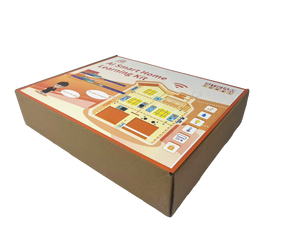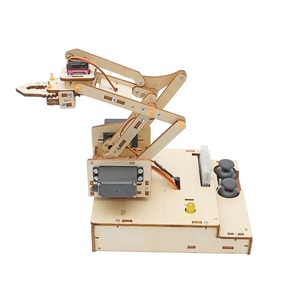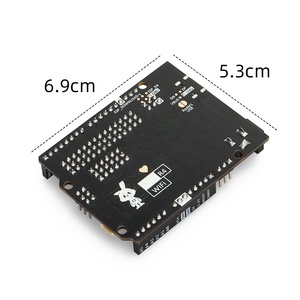(32 products available)



















































































































































More advanced users can try impressive ideas for Arduino projects. Most of these require many extra components and experience coding with Arduino.
Automated plant watering system
This advanced Arduino project shows how users can build an automated watering system. By adding a water pump and soil moisture sensor to the Arduino board, the water pump will spray water at set intervals or when the soil gets dry. Using a solar panel will give the device off-grid capabilities and other uses outside the home.
Home automation system
For advanced users, Arduino can control many things in a home. An Arduino-based home automation system can let users manage different devices in the home with their phone or an online dashboard. Combining an Android app, Bluetooth, and various sensors will make a strong home automation solution with full mobile control. Other modules like a gas sensor, smoke sensor, or temperature sensor will add many useful features for home safety.
Self-balancing robot
An advanced user can build a self-balancing robot with Arduino. This robot stands upright by itself. It uses a two-wheeled platform, an Arduino board, an accelerometer, and a gyroscope to balance. The robot will adjust itself continuously and stay upright, like a Segway. This project shows how well the user knows Arduino and robotics.
Gesture-controlled drone
The advanced user can also try creating a drone that responds to gestures. A quadcopter will be built and then controlled with an Arduino board and a gesture sensor. The user has to program the Arduino so the drone moves according to the person's hand movements. This complex project combines Arduino coding with drone building. It lets the advanced user introduce their unique control system. When finished, the project will let the drone fly in a new and exciting way.
Fingerprint door lock system
Using a fingerprint sensor can create an electronic door lock for a home or secure room. The user will program the fingerprint sensor with specific user fingerprints. When someone wants to enter, the fingerprint must match one stored in memory, or the door will not unlock. This advanced Arduino project provides extra security at home or for sensitive equipment.
Specifications of Arduino advanced projects can vary widely. Here are some general specifications that apply to most Arduino projects.
Advanced Arduino projects require maintenance to ensure they work well and properly. Here are some helpful tips for project maintenance:
Due to the low-cost open-source hardware and software combination, there are many advanced Arduino project ideas.
Smart home automation
The Arduino platform can be utilized to design models showcasing advanced home automation concepts. These could include an intelligent door lock system, an automated window-blind system, an air-quality monitoring system, etc.
Environmental monitoring
One can use advanced Arduino boards to create an intelligent device for monitoring environmental factors. These devices are capable of gauging components such as temperature, moisture, PH level, light intensity, carbon dioxide concentration, and more. Furthermore, the data collected by these devices can be analyzed and utilized for purposes like agriculture management, weather forecasting, and ecological observation.
Gesture-controlled robots
With an advanced Arduino board like Arduino Due, one can build a robot controlled by bodily gestures. This could involve using an accelerometer or a gyroscope to capture the movement of the human body and subsequently control the robot's actions by processing the data through the Arduino board.
Wearable devices
Advanced Arduino products can be used to create intelligent devices that one can wear. Such devices could include smart bracelets, fitness trackers, and healthcare monitors. They would have features like activity tracking, heart-rate monitoring, and sleep quality tracking, among others.
Smart agriculture
Smart agriculture facilitates automation and intelligent monitoring of agricultural operations using advanced Arduino projects. Examples include an automated irrigation system based on soil humidity, a greenhouse environment monitoring and controlling system, and a crop growth monitoring system.
Home automation
By using the advanced Arduino project, people can create personalized automation solutions for their homes. These might include an intelligent lighting system, a home security system, a temperature and humidity monitoring and controlling system, and more.
Nowadays many project ideas are available in advanced Arduino projects for teens and adults. But when it comes to retailing, buyers should choose ideas that are distinct and innovative. Here are a few ways to select unique project concepts.
Differences in usage scenarios
Look for distinct usage scenarios. For example, the advanced Arduino door projects like the smart locking system or the Arduino-based intercom. They may seem common but retail buyers should analyze their features. For the smart locking system, does it have a fingerprint lock or mobile application? The application has multiple locking types for different needs.
Integrated sensor technologies
Select projects that use different advanced sensors. For instance, the advanced weather station utilizes various weather sensors. They include a temperature and humidity sensor, an anemometer, a rain gauge, and more. Each of them performs a distinct function. Buyers should select projects that have distinct sensor combinations for specific applications.
New communication protocols
Select Arduino projects that showcase a new communication protocol. For example, the advanced smart home system may connect devices using Wi-Fi, Zigbee, or Bluetooth. Innovative communication allows devices to interact and share information quickly.
Advanced automation and control
Retails buyers should look for projects that feature advanced automation. For instance, an Arduino-based irrigation system can use a soil moisture sensor and weather station. By analyzing the weather, it can optimize irrigation schedules and reduce water wastage.
Q1 Can Arduinos be used outside?
A1 Yes, but they should be used in enclosed places. An enclosed advanced Arduino project for this is a climate-controlled box. It can also be used to monitor Arduino's outdoor use, where an IP-rated Arduino means it can be dust and water resistant.
Q2 What are the drawbacks of Arduino?
A2 The main disadvantages are that it is low-powered, lacks a built-in microSD card slot and is programmable only in C and C++.
Q3 How can users increase the memory of Arduino?
A3 One way is to add an external serial EEPROM. A more advanced method is to use an ATmega1284P microcontroller, which has more memory than the typical Arduino.
Q4 Can advanced users replace Arduino's microcontroller?
A4 Yes. Most Arduinos have removable microcontrollers. An advanced user can replace the existing one with a different one that has more features or memory.